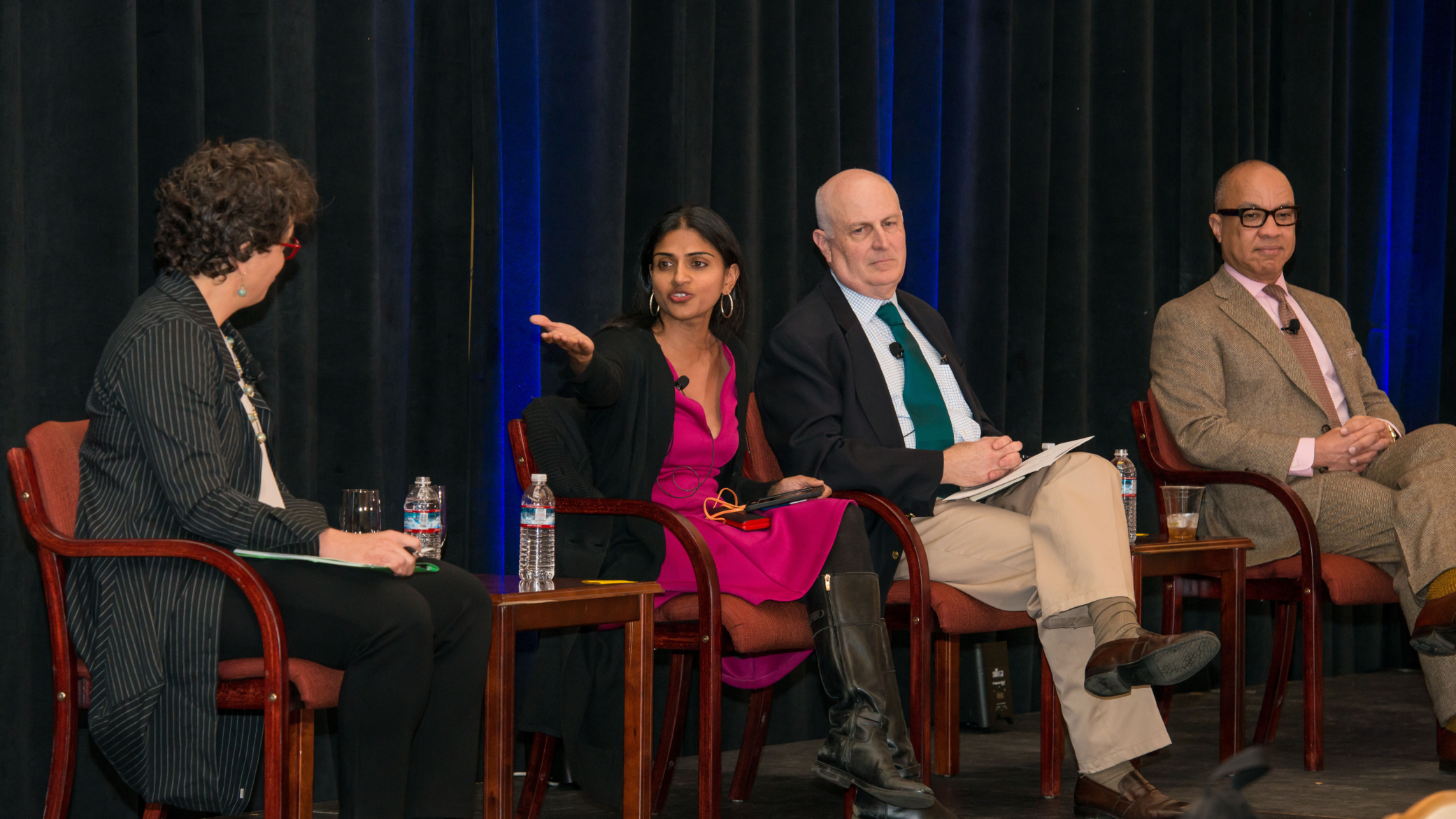Editor’s note: This essay is part of a series of symposium reflections.
To mark our 50th anniversary, the Hewlett Foundation hosted a special symposium last December at Stanford University. More than 300 leaders from across the social sector – foundation executives and nonprofit founders, conservatives and liberals, artists and policy wonks – joined us for a vibrant day and a half of learning and discussion about the history and future of the social sector.
Learning is a core value at the heart of the Hewlett Foundation’s workplace culture and its approach to philanthropy, and a symposium with our peers and partners seemed like the best way to honor that tradition while addressing many open questions about the future of the social sector. We had planned an event that brought together people with diverse views on tough social challenges, and with the foundation marking its golden anniversary, we had an implicit focus on the long arc of history. But with the symposium following on the heels of a divisive election that roiled the public, we had to ask ourselves: Is this the right thing for us to be doing right now?
As I reflect on the event, I can’t help but think it was right to press forward, to convene a diverse group of stakeholders, all committed to serving the public good and to creating lasting, meaningful change. We needed to ask ourselves, and each other, serious questions about the way we work and how we can do better. This is a time for us to be more curious and less certain – to question orthodoxies and derive inspiration from unexpected places. And above all, to remain unswerving in our commitments to solving the problems facing society in a manner that starts with evidence, embraces open debate, and seeks common ground.
These are my seven lessons from our day and a half of discussions at the symposium.
1. It is refreshing to learn from history
A new report by historians Benjamin Soskis and Stanley N. Katz on philanthropy in the past 50 years was enlightening in multiple ways. Not only did it address persistent and false claims of newness for so many philanthropic fads, it also illuminated for the audience a more clear-eyed arc of history in philanthropy. What characterized the sector 50 years ago when the Hewlett Foundation was born, was in many respects, a very different environment than today.
One of the clearest examples of this is the history of diversity. In the 1960s, the foundation world was a genteel place, concentrated on the East Coast, dominated by white Protestant men. We learn that Jews, blacks and women would have been considered as “intruders” in the employment ranks of foundations on those days. We have come a long way since then, and of course, there’s still a long way to go in our aspirations for more diversity in philanthropy. But, understanding that arc gives me optimism that more change is possible, maybe even undeniable.
2. In Silicon Valley, we often confuse innovation with effectiveness
The history research focused on the question of novelty in the sector, which is important, but perhaps the next paper should focus on which philanthropic approaches, when viewed through the hindsight of history, actually worked better than others. For instance, was Julius Rosenwald’s approach as a foundation creating schools to educate black children in the south uniquely successful? Why or why not? Rosenwald was among the first to affirmatively spend down his foundation’s assets – something many today are doing. Was that a good idea in light of his aims? Were there any legitimately bad ideas undertaken in philanthropy and what were they?
3. Listening to and learning from the experiences of the people we are seeking to help with our funding is the number one tool to help foundations achieve greater impact
We learned this from the Center for Effective Philanthropy’s research on the future, but it also surfaced throughout the symposium. Sendhil Mulhatinin of Harvard spoke about the importance of understanding the mental trauma that poor people suffer while contending with basic survival needs. Cecile Richards of Planned Parenthood spoke about the importance of putting people at the center of their considerations, to drive other decisions about organization and service delivery.
At one of my table discussions when we were talking about the value of community and beneficiary feedback, Stanley Katz argued that he would rather have real research on the nature of a problem and what might solve it, rather than rely on people’s input and opinions. I understand that argument and am sympathetic to it to a certain degree. What if people are wrong? We all have blind spots – things we can’t see that can lead us to faulty understanding. But really this is a false choice. We need both the analytics and the community, citizen and intended beneficiary feedback. Just look at the now well-known recent example of the failed $100 million Mark Zuckerberg gift to fix the Newark public schools. A primary reason for that failure was the lack of understanding of and connection to the people of Newark. All the analysis in the world doesn’t replace the need for trust and respect.
There is still a lot of work to do to help us bridge these gaps between those in philanthropy and those we seek to benefit. There are ways to work closer with nonprofits to do so, but the moment is long past due for us to take us the cause of listening and learning. That moment is now.
4. Art is peerless in its power to make us feel
The symposium featured a special performance by the artist Sarah Jones that let us walk in the shoes of many in the social sector. In her one-woman performance, she inhabited the characters of attendees at a fictional annual foundation meeting, helping us to see and feel the world from so many points of view and have compassion for all: the anguished philanthropist who inherits the foundation from his father but has a more conservative worldview; grantees who work tirelessly on correcting injustices to vulnerable people; to a teenage Somali immigrant who has been harassed but who has benefited from the foundation’s funding.
5. Coming together on agreements
All of our panel discussions featured diverse views but it is noteworthy during this highly polarized time in our nation that there were also many points of agreement that we can build upon. In a session on how to alleviate poverty – discussants disagreed about tactics such as minimum wage, but agreed on the values of empathy and an outcome orientation to poverty alleviation. In another session, there was agreement across ideological lines about the need for philanthropies to be free to be bold and experiment with new ways of working.
6. There was considerable mention of inflection points in the discussion of scale
Sometimes the inflection points referred to were big moments of change – an election, change in leadership, economic downturns or upturns that have been exploited for positive change in health care, or family planning or environmental sustainability. But, as I recently learned from my 16-year-old son who is studying calculus, mathematical inflection points are not always big and perceptible. It seems to me, that sometimes, sometimes, we also need to be looking out for even small inflection points – moments to build upon and bridge to a better world.
7. Learning comes in the conversation
We have perhaps never been in greater need of a well-functioning civil society – with independent funders and nonprofit organizations being as effective as possible – visionary and bold our about long term aspirations, strategic and creative in how we get there.
I am thankful to all who opened their hearts and minds to join the conversation.




